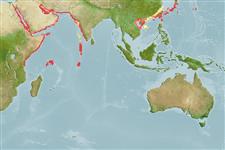>
Ovalentaria/misc (Various families in series Ovalentaria) >
Pomacentridae (Damselfishes) > Pomacentrinae
Etymology: Amphiprion: Greek, amphi = on both sides + Greek, prion, -onos = saw (Ref. 45335).
More on author: Rüppell.
Environment: milieu / climate zone / djupintervall / distribution range
Ekologi
marina revassocierade; ej vandrande; djupintervall 1 - 30 m (Ref. 9710). Tropical; 31°N - 7°S
Western Indian Ocean: Red Sea and Chagos Archipelago.
Size / Vikt / Age
Könsmognad: Lm ? range ? - ? cm
Max length : 14.0 cm TL hane/ej könsbestämd; (Ref. 9710)
Short description
Bestämningsnycklar | Morfologi | Morfometri
Taggstrålar i ryggfenan (totalt) : 9 - 10; Mjukstrålar i ryggfenan (totalt) : 15 - 17; Taggstrålar i analfenan: 2; Mjukstrålar i analfenan: 13 - 14. Yellow orange with 2 black-edged white bands, the first running just behind the head, the second from the notch between the spinous and soft dorsal fin to the abdomen.
Body shape (shape guide): short and / or deep; Cross section: compressed.
Life cycle and mating behavior
Könsmognad | Reproduktion | Lek | Ägg | Fecundity | Larver
Oviparous, distinct pairing during breeding (Ref. 205). Monogamous mating is observed as both obligate and social (Ref. 52884). Eggs are demersal and adhere to the substrate (Ref. 205). Males guard and aerate the eggs (Ref. 205). Sex reversal is completed in 26-145 days (Ref. 34185). In a field test, a functional male laid eggs in 26 days after removal of the female from the area (Ref. 240, 32167).
Allen, G.R., 1991. Damselfishes of the world. Mergus Publishers, Melle, Germany. 271 p. (Ref. 7247)
IUCN Red List Status (Ref. 130435: Version 2025-1)
Threat to humans
Harmless
Human uses
Fiskeri: kommersiell; Akvarium: Kommersiell
Verktyg
Special reports
Download XML
Internet-källor
Estimates based on models
Preferred temperature (Ref.
123201): 24.6 - 29.1, mean 27.4 °C (based on 589 cells).
Phylogenetic diversity index (Ref.
82804): PD
50 = 0.5000 [Uniqueness, from 0.5 = low to 2.0 = high].
Bayesian length-weight: a=0.02344 (0.01134 - 0.04848), b=2.98 (2.80 - 3.16), in cm total length, based on LWR estimates for this (Sub)family-body shape (Ref.
93245).
Trofisk nivå (Ref.
69278): 2.7 ±0.30 se; based on food items.
Resiliens (Ref.
120179): Hög, lägsta populationsfördubblingstid mindre än 15 månader (Preliminary K or Fecundity.).
Fishing Vulnerability (Ref.
59153): Low vulnerability (10 of 100).
🛈
Nutrients (Ref.
124155): Calcium = 93.7 [47.6, 145.6] mg/100g; Iron = 0.71 [0.44, 1.15] mg/100g; Protein = 18.2 [17.1, 19.4] %; Omega3 = 0.109 [0.069, 0.174] g/100g; Selenium = 25.1 [14.3, 45.9] μg/100g; VitaminA = 80.2 [22.4, 269.2] μg/100g; Zinc = 1.63 [1.12, 2.34] mg/100g (wet weight);
